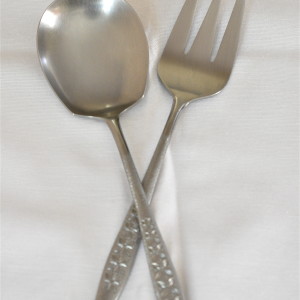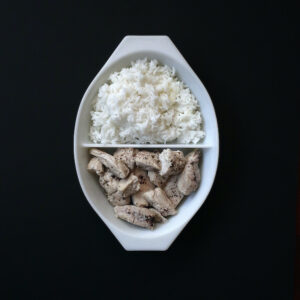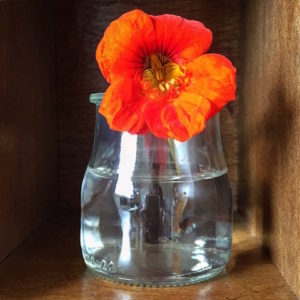Vietnamese Chicken Curry
Discuss kitchen equipment with passionate cooks and witness attachment to the most unlikely objects. Laurie Colwin had her cracked Meissen plate, which held any number of solo eggplant concoctions (see “Alone in the Kitchen with an Eggplant”, Home Cooking). Amanda Hesser has her bone-handled forks. (Cooking for Mr. Latte, The Best Food Writing, 2003). And here is the redoubtable Elizabeth David, writing in French Country Cooking:
As time goes on you accumulate your own personal gadgets, things which graft themselves on to your life; an ancient thin-pronged fork for the testing of meat, a broken knife for scraping mussels, a battered little copper saucepan in which your sauces have always turned out well, an oyster knife which you can no longer afford to use for its intended purpose but which turns out to be just the thing for breaking off hunks of Parmesan cheese…an earthenware bean-pot of such charm that nothing cooked in it could possibly go wrong.
I, until a couple nights ago, had this:

Well, technically I still have it, a Chinese sandpot whose generous 2.5 quart capacity most often held rice.
Sandpots are notoriously fragile items, evidenced by the wire cage wrapped around its body, a kind of built-in brace, the sort of support a person like me can empathize with. I’ve read these wire cages are removable, but I’d never dream of attempting such a maneuver. I understand what it means to arrive in the world so fragile your makers determine extramural bracing necessary. Far be it from me to remove it.
No matter: Sooner or later, Paula Wolfert warns in Clay Pot Cooking, these delicate pots eventually break. And the other night, as I oh-so-carefully brought the water to a boil beneath yet another pot of basmati rice, I noticed a hairline crack in my beloved Chinese sandpot. It exhaled, visibly expanding in the heat, until I turned the burner off, transferring the watery rice into another pot.
I carried the pot over to John, who was in his standing frame, watching the hockey playoffs. “Look!” I cried.
He found my reaction extreme. “How much did you pay for that pot?”
“Twenty-four dollars,” I replied. “Paula Wolfert says you can repair cracked sandpots by soaking them in milk.”
“At that price, it’s cheaper to get another pot.”
Given the size of the pot, John’s right. I held the pot, sadly unable to explain my grief as John looked on, bewildered. Normally he’s the one to hoard magazines, random scraps of paper, cassette tapes he can’t listen to on a machine we no longer have. I’m the one happily purging clothing I haven’t worn in two weeks. But I am the person for whom rice cookers were invented, a cook whose rice veers between crunchy and mushy. A rice cooker would solve this problem. But high-quality rice cookers are an investment, hundreds of dollars. Chinese sandpots are cheap, between nine and thirty dollars. They are elegant. They are ancient: in Introducing Chinese Casserole Cookery, Lilah Kan reports that the Sha Kuo Chu restaurant was established in the 1700’s. Sha Kuo Chu translates as “Home Of The Earthen Pot Casserole”.
Chinese sandpots produce perfect rice.
Hence my mourning.
“Maybe we can use it for a planter?” I suggested.
“Diane, it’s cracked.” He didn’t need to add “and so are you.” Nor would he. My husband is too nice for such utterances.
So I logged on to the internet and paid a virtual visit to The Wok Shop, where I purchased a new sandpot. Actually, I bought two sandpots, a 1.5 quart and a 2.5 quart. And, um, and a knife. But it was a really inexpensive knife. It cost five dollars.
So, this curry. I made it with leftover chicken, but you don’t have to. You can start with unleftover chicken, also called raw. It is best to use bone-in, because boneless chicken will become leathery before the potatoes are ready. Leathery is not a pleasant state of affairs unless you are describing a jacket. Or maybe a wine, should you be the sort who describes wines using inedible adjectives (notes of diesel and petroleum…really? how do you know? and what’s up with wet asphalt?)
The recipe comes from two places–three, actually, counting the IK: Diana Henry’s A Bird In The Hand, which has a terrific section on leftover chicken, and Jeffrey Alford and Naomi Duguid’s Hot Sour Salty Sweet, a book in heavy use Chez IK.

Before divorcing in 2009, Alford and Duguid were intrepid explorers of culinary Southeast Asia, publishing six must-have books. I had the great honor of interviewing Naomi Duguid in 2012 when Burma: Rivers Of Flavor came out. I’ve yet to meet a nicer person.

This recipe requires a bit of what Nigella Lawson would call faffing in the kitchen, but none of it is difficult faffing, and you could skip the faffing in favor of tossing everything into the pot. But the faffing affords depth of flavor.

Know, too, that this curry is less about knock-your-head off spiciness than a slowly building heat. The coconut milk mellows the red pepper’s bite. Still, if spicy heat is not your bag, feel free to cut back.
Leftover chicken usually doesn’t improve over time. This is a rare dish that does, getting better over a couple days, though it’s unlikely to last that long.

Vietnamese Chicken Curry
Adapted from Diana Henry’s A Bird In The Hand and Jeffrey Alford and Naomi Duguid’s Hot Sour Salty Sweet
yield: 3-4 generous servings with rice
prep time: 30 minutes with cooked leftover chicken, about 60 minutes if starting with raw chicken
2-4 garlic cloves, peeled
2 dried red chiles (see note)
1 tablespoon coriander seed
1 shallot, peeled and thinly sliced
1 scallion, trimmed and sliced into thin rings
2 tablespoons peanut oil
2 medium sweet potatoes, peeled and cubed
2 small Yukon Gold or other waxy potatoes, scrubbed and cut into small pieces
1/2 tablespoon turmeric
1 13.5 ounce can coconut milk
3/4 cup home-made or low salt chicken broth
1 tablespoon fish sauce
1 1/2-2 pounds bone-in chicken pieces (leg and thigh are best here)
juice of 1 lime, plus more for serving
fresh basil leaves, for the top
Using a mortar and pestle or small food processor, grind the garlic, chiles, and coriander to a paste. Set aside.
Place a lidded stewpot or wok large enough to hold all the ingredients on the stove. Pour in the peanut oil and heat to medium-high. Stir fry the shallots and scallions for about a minute. Add chile paste and stir fry, taking care not to burn the paste.
Add the sweet potatoes, Yukon Golds, turmeric, coconut milk, chicken broth, and fish sauce. Stir to blend.
If your chicken is raw, add it now. Bring curry to a gentle simmer and cover the pot. Check frequently, stirring. It should take about an hour to cook.
If you are using cooked chicken, the potatoes will need about 25 minutes to cook through. Bring curry to gentle simmer, cover, and check frequently, stirring. Tear chicken into bite-sized pieces. Add during final 5 minutes of cooking to heat through.
Add lime and shredded basil at end of cooking. Serve over basmati rice.
Notes: add or subtract chiles depending on your heat tolerance; garlic can also be adjusted to your preference.





